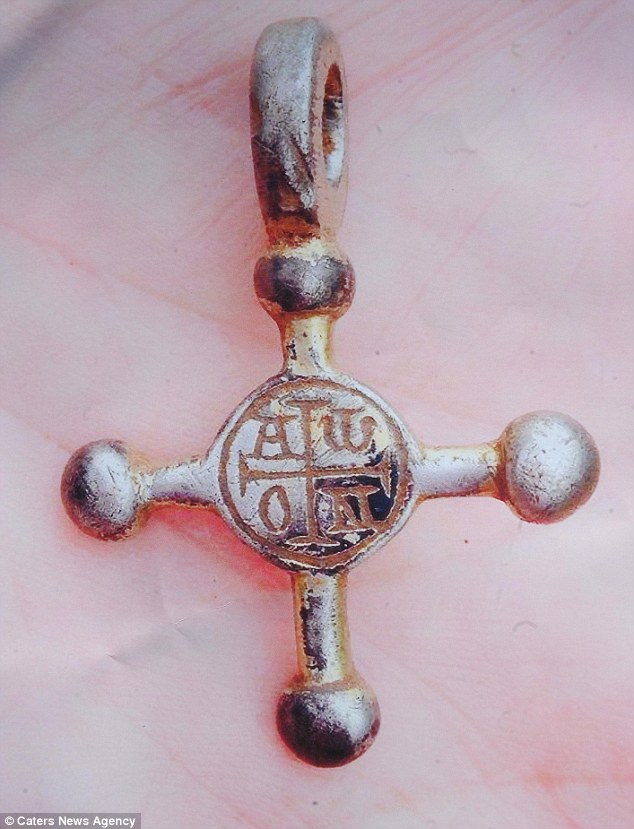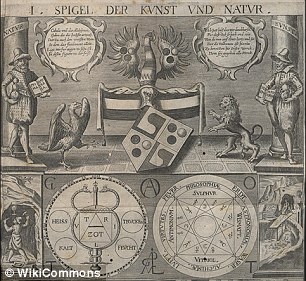An amateur metal detectorist has made the 'find of a lifetime' after he discovered a medieval trinket.
Malcolm Corfield, 63, found the inch-long cross pendant buried less than a foot underground in Newport.
The charm, which is thought to date back 800 years, is in fantastic condition with a Hebrew inscription clearly reading 'Ate gebir leilam adonal'.
This translates as 'Thou art mighty forever oh Lord', and was a common charm used to ward off fever in the Middle Ages.
Stunning 800-year-old crucifix engraved with a Hebrew talisman to ward off fever is unearthed in Wales
Malcolm Corfield, 63, found crucifix buried eight inches underground
Charm in great condition with inscription reading 'Ate gebir leilam adonal'
Hebrew translates as 'thou art forever oh Lord' and to ward off illness
If cruciform is deemed treasure, museums will be able to bid for it
By Rachel Reilly for MailOnline
19 August 2015
Daily Mail
An amateur metal detectorist has made the 'find of a lifetime' after he discovered a medieval trinket.
Malcolm Corfield, 63, found the inch-long cross pendant buried less than a foot underground in Newport.
The charm, which is thought to date back 800 years, is in fantastic condition with a Hebrew inscription clearly reading 'Ate gebir leilam adonal'.

Malcolm Corfield, 63, found the inch-long crucifix (pictured) buried eight inches underground in Newport
This translates as 'Thou art mighty forever oh Lord', and was a common charm used to ward off fever in the Middle Ages.
The other side of the pendant reads 'AWON', but experts are yet to work out what this might mean, although it is probably an acronym for a religious prayer or phrase.
While the artefact is now in the hands of a coroner, Malcolm hopes that it will remain in Wales.
If the cruciform is deemed to be treasure, museums all over the UK will be able to bid for it. It is not yet known how much it is worth.
Malcolm, who has only been a metal detector for two years with Gwent Detecting Club, found the tiny silver and gold trinket with only 30 minutes to go on a charity rally with the club.
Since taking up detecting as a hobby Malcolm has unearthed a Bronze Age brooch and Elizabethan silver hammered coins, but he says this most recent find is in another league.


Treasure hunter: Malcolm (pictured) has previously found a Bronze Age brooch and Elizabethan silver hammered coins, but he says this most recent find in Newport (marked) is in another class
He said: 'You always live in hope that you'll find an exceptional item, but it was slow day. I was drawing a blank.
'Then, there was a faint signal. It was in unbelievable condition, just dropped off the neck. I had goose bumps. I couldn't believe what it was. It was the find of a lifetime.
'You just think of the person who lost it and their circumstances. That makes you pause for thought.
'Hopefully Cardiff Museum will bid to keep it in Wales so that other people can look at it. We need to save as much as we can.'
WHAT DOES THE INSCRIPTION MEAN?

Hebrew phrases were thought to possess great mystical powers (17th century manuscript pictured)
The 13th century charm bears a Hebrew inscription reading 'Ate gebir leilam adonal'.
This translates as 'thou art mighty forever oh Lord', and was a common charm used to ward off fever in the Middle Ages.
During the Middle Ages, Hebrew had a reputation as a language possessing great mystical powers, even after the expulsion of the Jews from England in 1290.
This use also highlights the Judaic roots of Christianity - as well as underlining the irony of persecuting the culture that Jesus came from.
The talismans were also used in kabbalah - Jewish mysticism - as the words were thought to work in a similar way to spells to protect and ward off evil.
The inscription can also be found on rings and brooches from the period.
Malcolm Corfield, 63, found the inch-long cross pendant buried less than a foot underground in Newport.
The charm, which is thought to date back 800 years, is in fantastic condition with a Hebrew inscription clearly reading 'Ate gebir leilam adonal'.
This translates as 'Thou art mighty forever oh Lord', and was a common charm used to ward off fever in the Middle Ages.
Stunning 800-year-old crucifix engraved with a Hebrew talisman to ward off fever is unearthed in Wales
Malcolm Corfield, 63, found crucifix buried eight inches underground
Charm in great condition with inscription reading 'Ate gebir leilam adonal'
Hebrew translates as 'thou art forever oh Lord' and to ward off illness
If cruciform is deemed treasure, museums will be able to bid for it
By Rachel Reilly for MailOnline
19 August 2015
Daily Mail
An amateur metal detectorist has made the 'find of a lifetime' after he discovered a medieval trinket.
Malcolm Corfield, 63, found the inch-long cross pendant buried less than a foot underground in Newport.
The charm, which is thought to date back 800 years, is in fantastic condition with a Hebrew inscription clearly reading 'Ate gebir leilam adonal'.

Malcolm Corfield, 63, found the inch-long crucifix (pictured) buried eight inches underground in Newport
This translates as 'Thou art mighty forever oh Lord', and was a common charm used to ward off fever in the Middle Ages.
The other side of the pendant reads 'AWON', but experts are yet to work out what this might mean, although it is probably an acronym for a religious prayer or phrase.
While the artefact is now in the hands of a coroner, Malcolm hopes that it will remain in Wales.
If the cruciform is deemed to be treasure, museums all over the UK will be able to bid for it. It is not yet known how much it is worth.
Malcolm, who has only been a metal detector for two years with Gwent Detecting Club, found the tiny silver and gold trinket with only 30 minutes to go on a charity rally with the club.
Since taking up detecting as a hobby Malcolm has unearthed a Bronze Age brooch and Elizabethan silver hammered coins, but he says this most recent find is in another league.


Treasure hunter: Malcolm (pictured) has previously found a Bronze Age brooch and Elizabethan silver hammered coins, but he says this most recent find in Newport (marked) is in another class
He said: 'You always live in hope that you'll find an exceptional item, but it was slow day. I was drawing a blank.
'Then, there was a faint signal. It was in unbelievable condition, just dropped off the neck. I had goose bumps. I couldn't believe what it was. It was the find of a lifetime.
'You just think of the person who lost it and their circumstances. That makes you pause for thought.
'Hopefully Cardiff Museum will bid to keep it in Wales so that other people can look at it. We need to save as much as we can.'
WHAT DOES THE INSCRIPTION MEAN?

Hebrew phrases were thought to possess great mystical powers (17th century manuscript pictured)
The 13th century charm bears a Hebrew inscription reading 'Ate gebir leilam adonal'.
This translates as 'thou art mighty forever oh Lord', and was a common charm used to ward off fever in the Middle Ages.
During the Middle Ages, Hebrew had a reputation as a language possessing great mystical powers, even after the expulsion of the Jews from England in 1290.
This use also highlights the Judaic roots of Christianity - as well as underlining the irony of persecuting the culture that Jesus came from.
The talismans were also used in kabbalah - Jewish mysticism - as the words were thought to work in a similar way to spells to protect and ward off evil.
The inscription can also be found on rings and brooches from the period.